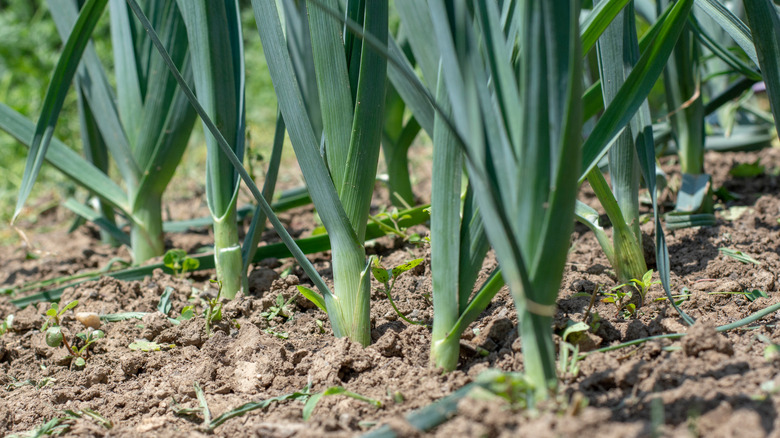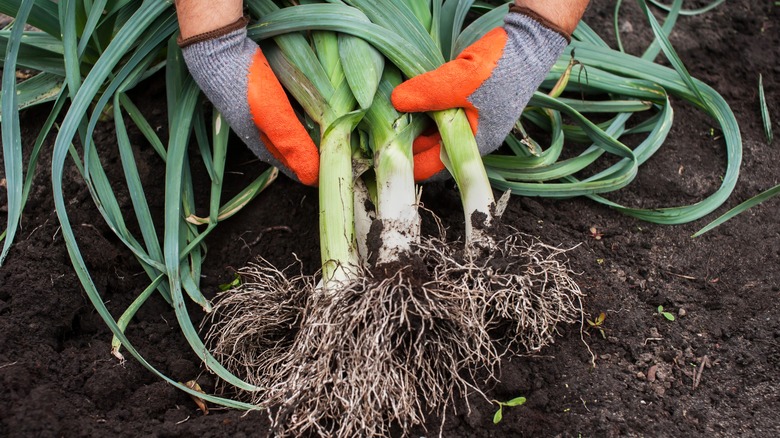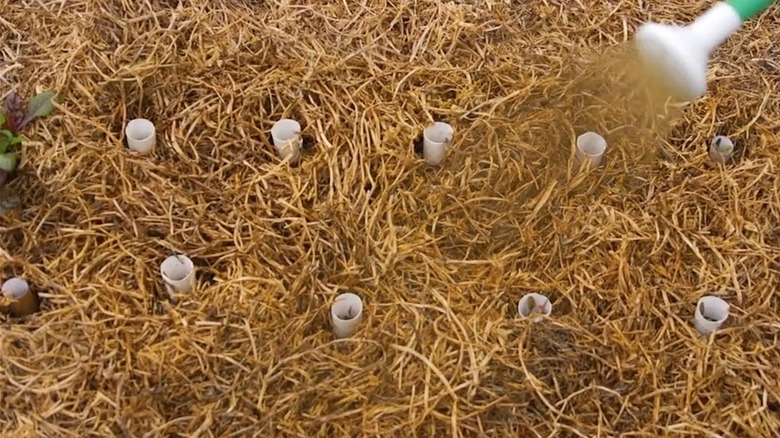The Best Time To Harvest Leeks
Leeks are like scallions' cool older cousin who's visiting from abroad and whom everyone wants to hang out with. They're basically the chill buddies in your garden and are ready to harvest when the white part of the shaft is around 1 to 3 inches, depending on your varietal. But generally speaking, from late summer until the ground gets all frosty, you can just pluck a few whenever you fancy. When you grab them early in their infancy, when they're about the size of your finger, you can expect a more mild and tender taste. But mature, Hulk-sized leeks will have a heartier and more robust flavor. On top of that, the larger, more mature leeks aren't going to go away after one season. Unlike their allium cousins, leeks don't die back. In fact, in areas with milder weather, this fragrant vegetable might even bloom for a second year, like carrots.
That being said, leeks are a bit finicky about when and where they grow. Their favorite seasons are early spring and late summer. Starting from late February to early April, when the ground still has that leftover winter moisture, is when you'll want to start tossing those leek seeds or baby plants into the earth. Late summer, around mid to late August, is the leek's other preferred planting sweet spot.
How to successfully grow leeks
If you want to grow some top-notch leeks, you'll need a few essentials. First, source out some high-quality seeds or seedlings from a reputable nursery or home and garden center. Next, scout out a spot in your garden that gets plenty of sunlight, good drainage, and soil that's rich in all the good stuff plants crave. Don't let poor soil quality put a damper on your leek harvest. Always test before jumping in and planting. It's recommended to toss in some compost or organic fertilizer to help give your soil a nice leg up. When the weather's right, plant your seeds or seedlings and water them so that the ground is saturated but not soggy.
If you're itching to get your leeks growing, but it's not the right season, you can start seeds indoors around 10 to 12 weeks before the end of winter. When those seedlings reach the ripe old age of eight weeks, and you've still got another month to go before frost melts away into the rains of spring, it's time to plant. Growing leeks is all about having the patience of a saint and nailing perfect timing. And that means choosing the right planting time, giving them some prime soil, and making sure they're cozy with consistent moisture, mulch, and protection from inclement weather.
Keep them cool and covered
It's already been established that leaks prefer cooler and milder weather. That's because when it gets a bit chilly outside, leeks like to take things easy and grow at a leisurely pace. This chill time allows the natural sugars to accumulate, which is what gives them that lovely, delicate flavor. Plus, this cooler weather keeps the leeks from bolting, which makes them focus all of their energy on the yummy parts so that they taste nice and flavorful. If you live in an area where Mother Nature has some serious mood swings, you might want to toss some row covers to keep your leeks safe from any episodes of rollercoaster-esque weather. Don't forget to pick leek varieties that jibe with your local weather, because some varieties can handle a bit of warmth while others will droop when the thermostat begins to climb.
Have you ever sliced open a leek only to find it riddled with so much dirt that it seems more of a chore to clean it than it is to cook it? A nifty little trick is to use cardboard tubing from a roll of toilet paper or paper towels to act like a protective shield. When your little leek buddies are just starting out, grab a paper tube, and slide it over the seedlings. This tube will eventually break down as the season rolls on, but it's a good buddy to have because it stops dirt from sneaking into the leaves when your leeks are in their early stages.


